
Elysia diomedea
(Bergh, 1894)
Order: SACOGLOSSA
Superfamily: ELYSIOIDEA
Family: Elysiidae
DISTRIBUTION
Pacific coast of central America. Found throughout the Gulf of Panama. Common in Gulf of California
PHOTO
Ecuador. Photo: Soledad Luna
Previously placed in the monotypic genus Tridachiella MacFarland, 1924. Very folded parapodial edge. Characteristic black and yellow lines on rhinophores. Grows to about 50mm in length, and found from the intertidal to about 20m.
It has long been considered related to the Caribbean E. crispata, first being described as a species of Tridachia [E. crispata was peviously in Tridachia], because of its extremely folded parapodia, and then placed in a subgenus, Tridachiella (MacFarland, 1924) because of the anterior gap separating the parapodia. The parapodia in E. diomedea are not joined anteriorly and branches of the digestive gland ramify into the sole of the foot causing green patches, similar to E. clarki. However, it differs considerably from E. clarki in colour and in having an extremely folded edge to the parapodia, as in E. crispata. Furthermore, while in E. clarki, the green on the sole of the foot is interspersed with rounded and oval whitish spots, in E. diomedea the translucent white regions are broken lines running parallel to the long axis of the body. Elysia diomedea also differs in having a characteristic pattern of black and white lines running down the rhinophores onto the head. Other differences in colour, compared to E. clarki, are the small blue spots scattered over the dorsum and inner walls of the parapodia, and a border of black spots, and sometimes red or orange spots, on the parapodial edge.
E. crispata, E. clarki and E. diomedea retain living chloroplasts which continue to photosynthesise within the body of the sea slug, providing it with sugars for its own nutrition. See the page on Solar powered sea slugs for further information. The process of taking chloroplasts from algal cells and keeping them has been given the name kleptoplasty
See separate message [#16728] comparing E. crispata, E. clarki and E. diomedea.
- Bergh, R. (1894) Reports on the dredging operations off the West Coast of Central America to the Galapagos, to the West Coast of Mexico, and in the Gulf of California, in charge of Alexander Agassiz, carried on by the U.S. Fish Commission Steamer "Albatross", during 1891, Lieut. Commander Z.L.Tanner, U.S.N., Commanding. XIII. Die Opisthobranchien. Bulletin of the Museum of Comparative Zoology 25(10): 125-233.
- Marcus, Ev. 1982 Systenatics of the genera of the Order Ascoglossa (Gastropoda). Supplement 10, Journal of Molluscan Studies: 1-31.
Rudman, W.B., 2006 (May 29) Elysia diomedea (Bergh, 1894). [In] Sea Slug Forum. Australian Museum, Sydney. Available from http://www.seaslugforum.net/find/elysdiom
Related messages
Sea Slugs from Costa Rica
March 24, 2010
From: Victor Cespedes
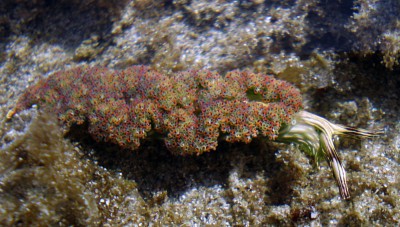

Hi, just took this pics and I was looking for the correct identification.
From all I could compare it's Elysia diomedea. Just wanna be sure. And the other one [lower photo] may be Navanax aenigmaticus.
Interesting fact I read Navanax aenigmaticus feeds of Tridachia crispata. Would they eat Elysia diomedea too ??? Or its just an identification error, because I also read they used to name E. diomedea as T. crispata ...
Locality: Playa Blanca, Punta Leona, 0, Puntarenas, Costa Rica, Pacific, 1 march 2010, intertidal. Length: .... Photographer: Víctor Céspedes Castro.
Víctor Céspedes Castro
cespedes.v@gmail.com
Cespedes, V., 2010 (Mar 24) Sea Slugs from Costa Rica. [Message in] Sea Slug Forum. Australian Museum, Sydney. Available from http://www.seaslugforum.net/find/23383
Dear Victor,
Have a look at my message #16728 for a discussion on the differences between E. diomedea, E. crispata and a recently recognised species E. clarki. Your animal is Elysia diomedea. If you follow the links and go to the relevant Fact Sheets you will find out more about these three species. We no longer use the names Tridachia and Tridachiella so the three species are all considered to be species of Elysia at present.
Concerning Navanax aenigmaticus: I have noted on the Fact Sheet that Humann reports that it feeds on Elysia crispata in the Caribbean. I guess it's highly probable that it feeds on Elysia diomedea in the East Pacific.
Best wishes,
Bill Rudman
Larval rearing in Elysia diomedea
September 23, 2008
From: Patrick Krug
Concerning message #21810:
Jake, regarding development in Elysia diomedea - this species is reported to have planktotrophic development, and the pictures of egg masses from your slugs confirm this (tiny eggs, packed densely together.) It would likely take a month to culture the hatching larvae through to metamorphosis by feeding them microscopic algae; I've done it for a few sacoglossans, and it is a lot of work. The reason the egg mass disappeared on you is that it hatched, dispersing the microscopic larvae into your aquarium, where they sadly won't make it.
Its Caribbean sister species Elysia crispata has lecithotrophic larvae, meaning much larger ones that don't need to feed; they can metamorphose before, or immediately upon, hatching. It is thus much easier to get juveniles to study in lecithotrophic species.
It's interesting to note that since E. diomedea and E. crispata speciated following the closure of the Isthmus of Panama, lecithotrophic development has evolved in E.crispata during the last 3 million years -- not a long time, in an evolutionary sense.
Cheers,
Pat
pkrug@calstatela.edu
Krug, P. J., 2008 (Sep 23) Larval rearing in Elysia diomedea. [Message in] Sea Slug Forum. Australian Museum, Sydney. Available from http://www.seaslugforum.net/find/21911Thanks Pat,
Can we be sure that E. crispata and E. diomedea have a common ancestor? Morphologically E. clarki seems to have more similarities to E. diomedea than to E. crispata. Has E. diomedea been included in any of the molecular analyses of the group?
Best wishes,
Bill Rudman
Re: Elysia diomedea feeding requirements
August 21, 2008
From: Jake Weston

Concerning message #21810:
Hey Bill
Thanks for posting my photo and comment. I wasn't sure if it would make it!
I will attach a better close up of the rhinophores of my E. diomedea - this was my first time taking photos of my slug so I will work to get some more interesting shots (hopefully some grazing ones).
Unfortunately, that very day that I sent you my photos, the egg ribbon that I saw disappeared. I did however get a photo of it before they it got eaten (I assume)- so i will try to dig that up for you.
Thanks again,
Jake
jokeweston@gmail.com
Weston, J., 2008 (Aug 21) Re: Elysia diomedea feeding requirements. [Message in] Sea Slug Forum. Australian Museum, Sydney. Available from http://www.seaslugforum.net/find/21823Dear Jake,
Thanks for the extra photo. I look forward to any more showing specific details or shots of your animal 'doing something' like laying eggs, feeding etc.
Although there are many beautiful photos of sea slugs in colour picture books and websites, it is surprising how difficult it is to find specific anatomical details - such as are the rhinophores a rolled tube or a solid cylinder? - when you have a problem to solve.
Best wishes,
Bill Rudman
Re: Elysia diomedea feeding requirements
August 19, 2008
From: Jake Weston
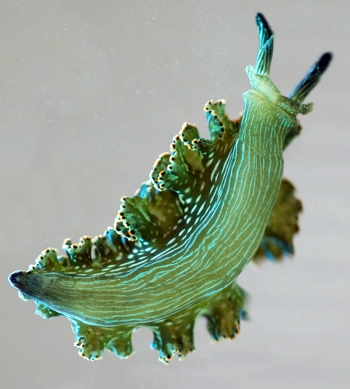
Concerning message #4509:
My Elysia diomedea will chomp down on mostly green algae species - my slug will clean the top 2-3 inches of my glass religiously, as well as grazing on live rock. I purchased it to help control my green hair algae (what i believe to be Bryopsis) and I have observed it munching down on fully grown strands of the awful Bryopsis. I have only had my slug for about 2 weeks or so and I think it layed a nice ribbon of eggs last night on a piece of liverock. These things are beautiful.
Locality: Monterey Peninsula, n/a, CA, USA, Unknown, August 15th, 2008, Reef tank. Length: 40 mm. Photographer: Jake Weston.
Jake Weston
jokeweston@gmail.com
Weston, J., 2008 (Aug 19) Re: Elysia diomedea feeding requirements. [Message in] Sea Slug Forum. Australian Museum, Sydney. Available from http://www.seaslugforum.net/find/21810
Dear Jake,
Thanks for the background information. There are a number of photos of this species' eggs on the Forum [see message #16793]. As you have only had your slug for two weeks it is possible that it mated before you bought it. If so, it is possible its eggs are fertile. It will be interesting to hear if you have any success in raising young Elysia. I don't think we have any information on breeding in captivity in your species but there is some information on two other species, E. clarki and E. crispata, which have commonly been called 'lettuce slugs'. However because their identity has been confused in the past I am not sure if the information available refers just to E. clarki or to both species. Have a look through the relevant messages attached to the Fact Sheets for both those species.
I have attached a close-up of your photo as it shows the rolled structure of the rhinophores [head tentacles] in this species.
Best wishes,
Bill Rudman
Re: Elysia diomedea breeding in home aquarium
June 7, 2006
From: Skip Pierce
Concerning message #16793:
Hi Bill,
I don't know anything about feeding in E. diomedea, but in answer to your comment about E. clarki and E. crispata. As juveniles, E. clarki eats Bryopsis (and Derbesia, but not Caulerpa) and will grow to adults on it-although in the field the adults eat Penicillus and Halimeda (but not Caulerpa). They seem to be able to switch over at about 1 cm. We know less about E. crispata juveniles. In the lab they did not eat anything we tried (Bryposis hypnoides, B. pennata or C. verticellata). The adults of E. crispata eat Penicillus or Halimeda, but not Caulerpa. Don't know about Bryopsis. With respect to the E. crispata juveniles, we were working on egg masses from animals collected in the Virgin Islands and shipped to Tampa - so while their larval development looked "fine" from a gross perspective and a large number hatched and metamorphosed, there may have been some problems due to the shipping.
Skip Pierce
pierce@cas.usf.edu
Pierce, S.K., 2006 (Jun 7) Re: Elysia diomedea breeding in home aquarium. [Message in] Sea Slug Forum. Australian Museum, Sydney. Available from http://www.seaslugforum.net/find/16806Dear Skip,
Thanks for the summary. For those aquarium keepers who are breeding various "Lettuce Slugs" the food of juvenile Elysia crispata is clearly still not resolved. If you have some in you aquarium, photos of them with their 'food' algae could be a valuable discovery. Have a look at my message #16728 where I compare 'true' E. crispata and the new species E. clarki.
Best wishes,
Bill Rudman
Elysia diomedea breeding in home aquarium
June 5, 2006
From: Matt Pedersen

Bill,
Following my earlier messages [#15228 ], here are some more images of my Elysia diomedea. This was another of MANY egg ribbons laid by the Diomedeas. They are still producing egg ribbons and I'm willing to ship them within the US to anyone who'd like to try to raise them provided the recipient pays for shipping. For additional info, see my post on Reef Central - http://www.reefcentral.com/forums/showthread.php?s=&threadid=838301 - the waiting list is currently a couple of people and the size of the egg ribbons is starting to drop (the pair is now rather "old" and is likely to complete their lifespan soon).
Best Regards,
Matt Pedersen
matt@cichlidrecipe.com
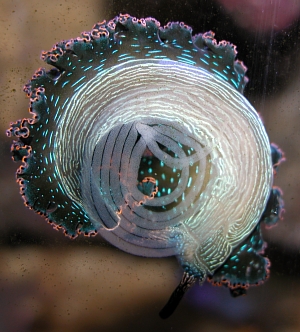


Dear Matt,
Thanks for the photos and the information on breeding these species of Elysia. I have had a look at Reef central message board and it seems people have had success at breeding E. diomedea, E. clarki and possibly E. crispata, but since the last two species have only just been sorted out it is a bit hard to be sure what 'E. crispata' means in earlier messages.
Looking through the messages on Reef cemtral it seems the two important points are to have filters on pump intakes so the swimmng veliger larvae are not sucked in, and to have a colony of the green alga Bryopsis, on which the larvae of the three species apparently settle and begin feeding. This is an interesting observation and needs confirmation. At present E. clarki juveniles are known to feed on Bryopsis, but I am not sure if earlier observations of E. crispata on Bryopsis refer to 'true' E. crispata or to E. clarki. I am not sure if there is any other information on the biology of E. diomedea.
I think it would be useful to have Fact Sheets on some of the common algae eaten by sacoglossans so if anyone has photos of Bryopsis I would be grateful
Best wishes,
Bill Rudman
Are these 'lettuce nudibranch' eggs?
November 26, 2005
From: Karen Hair

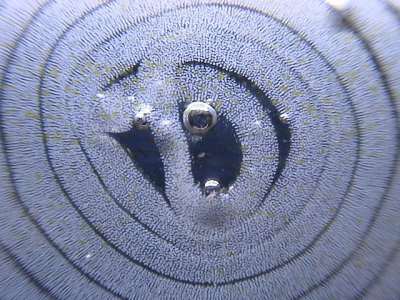
I bought 6 of these amazing creatures less then a week ago, one went into my 75g, today it layed these eggs?
And in another tank I put 3. One layed these today. Are they eggs ( I assume they are). What is the gestation of them? Here is the second nudi egg batch. Length: 1 1/2 inches. Photographer: Karen Hair
Karen Hair
karensaltwater1@att.net
Hair, K., 2005 (Nov 26) Are these 'lettuce nudibranch' eggs?. [Message in] Sea Slug Forum. Australian Museum, Sydney. Available from http://www.seaslugforum.net/find/15346Note added 23 Jan 2006: On reflection this is most probably Elysia diomedea, the East Pacific species. The dark spots along the edge of the parapodia and the elongate green bands on the sole of the foot can be seen in other photos on the Forum..... Bill Rudman
Dear Karen,
Yes this is Elysia crispata. I know people call this the Lettuce Nudibranch, but it's not a very good name because it is not a nudibranch. Nudibranchs are a special group of carnivorous [animal eating] sea slugs while Elysia is a 'Sacoglossan', which is a group of herbivorous [plant eating] sea slugs.
If you look at the earlier messages on this species which are attached to the Fact Sheet you will see discussions on other people's experience at breeding these slugs in aquaria.
Best wishes,
Bill Rudman
Elysia diomedea life span
July 28, 2005
From: Rebecca Rissanen
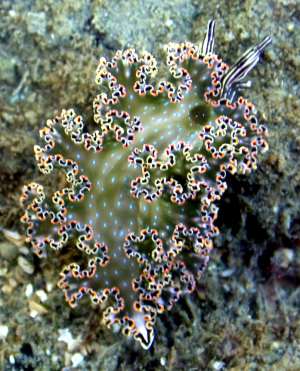
Hello again!
Once more, looking for information on our local slugs, I'm turning to the Sea Slug Forum. I must say, its once of the most complete sources of information I've run into while browsing the web. My question this time is, does anyone know how long (exactly or approximately) do Elysia diomedea live? And what's the reproductive cycle like (how long after eggs are laid are they hatched, what stages do they go through and for how long?)?
Locality: Punta Culebra, Panama, Pacific Ocean. Depth: about 30 cm. Length: 5 cm aprox. 25 July 2005. Rocky Intertidal. Photographer: Rebecca Rissanen
Thanks again for a great site! Here's a few pictures of our frilly guys.
Rebecca
rissanenj@si.edu
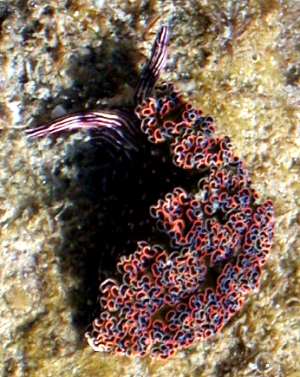
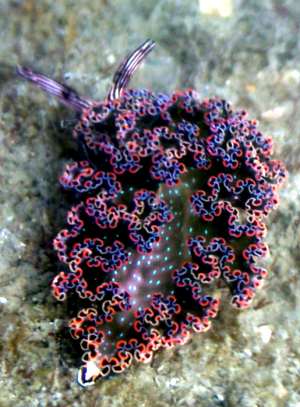
Dear Rebecca,
Thanks for the photos - it certainly is a beautiful elysiid. I can't find any published work on its lifecycle or natural history, but someone else may know of some work, published or unpublished. In Peter Ajtai message [#7075] there is a photo of the egg ribbon, and the very tiny eggs suggest that the larvae hatch as microscopic free-swimming veligers, which spend some time in the plankton feeding on microscopic plants, before settling out of the water, to begin life as a small crawling slug.
Best wishes,
Bill Rudman
Elysia diomedea from the Sea of Cortez
October 1, 2003
From: Marli Wakeling

Hi Bill,
This looks like an Elysia, but as I'm unfamiliar with this region, could you please identify this critter? Again, from the Sea of Cortez.
Date: Sept. 2003
Photo: Rand McMein
Many thanks,
Marli Wakeling
scubamarli@excite.com
Dear Marli,
This is Elysia diomedea. When the parapodia are tightly folded it looks rather different, but the white lines on the rhinophores seem to be fairly consistent.
Best wishes
Bill Rudman
Elysia diomedea from Ecuador
August 21, 2003
From: Soledad Luna

Dear Bill,
Here is a very common sea slug found in the intertidal zone as well as in the subtidal from several localities in the coast of Ecuador. In the subtidal we found it between 20 to 40 ft depth. Its size varied from 5 to almost 10 cm. We found it mostly on green filamentous algae.
Could you please help us with the identification?
Thank you!!
Soledad
soledadl@mail.usfq.edu.ec
Luna, S., 2003 (Aug 21) Elysia diomedea from Ecuador. [Message in] Sea Slug Forum. Australian Museum, Sydney. Available from http://www.seaslugforum.net/find/10784Dear Soledad,
This is Elysia diomedea, which was previously known as Tridachiella diomedea. Also have a look at the page on its counterpart from the Caribbean, Elysia crispata.
Best wishes,
Bill Rudman
Elysia diomedea from Mexico
June 25, 2003
From: José Luis Serrano

Hi:
I tried to find my nudi on the list with no success. I just want to know about it cause it was an impulsive purchase. I bought it on the fish store (Mexico City). I don't know from where it came from (the LFS neither), it is about 3 inches long. I thought it was a Elysia crispata, but the pattern of lines along the body (instead of "spots") and the "horn" shape changed my mind.
Thanks a lot in advance
José Luis Serrano.
joseluis@mecadigital.com
Serrano, J.L., 2003 (Jun 25) Elysia diomedea from Mexico. [Message in] Sea Slug Forum. Australian Museum, Sydney. Available from http://www.seaslugforum.net/find/10304Dear José,
I think your animal is Elysia diomedea, which is common on the Pacific coast of Mexico. It is quite similar to E. crispata so if you are lucky it should survive in your aquarium. If you look through the earlier messages on E. diomedea you should find some clues on what to do to keep it happy. Hopefully someone will be able to confirm my identification
Best wishes,
Bill Rudman
Elysia diomedea from Costa Rica
June 2, 2002
From: Peter Ajtai

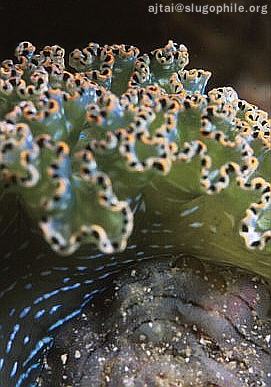
Dear Bill,
Elysia diomedea is the most common slug I see along the Pacific coast of Costa Rica.
In the lower photo the E. diomedea is laying its egg mass. The photos are from Bahia Culebra from the northwestern coast of Costa Rica. It is a bay with patch reefs of corals, no true river outflow, and all of the land around it is zoned for hotels.
Cheers,
Peter Ajtai.
http://www.slugophile.org
ajtai@slugophile.org
Ajtai, P., 2002 (Jun 2) Elysia diomedea from Costa Rica. [Message in] Sea Slug Forum. Australian Museum, Sydney. Available from http://www.seaslugforum.net/find/7075Thanks Peter,
Bill Rudman
How to raise Elysia crispata
December 19, 2001
From: Matt Galvin

I was looking over the page on E. crispata and thought I'd send you a picture I have of mine laying eggs. The slug that I have lays eggs quite often. It seems like at least once a week. I am very interested in trying to actually raise them past the egg stage and am hoping you can give me any additional information to help? I have read everything on that is currently posted on the page, so no need to repeat what was there.
Thanx!
Matt
luminary@liquidchaos.net
Galvin, M., 2001 (Dec 19) How to raise Elysia crispata. [Message in] Sea Slug Forum. Australian Museum, Sydney. Available from http://www.seaslugforum.net/find/5850Note: This is E. diomedea. See Erwin Koehler's message.
Dear Matt,
From Kathe's message, and Jeff Zimmerman's, it seems you need a good light source (for plant growth) and an alga the juveniles will eat. Jeff seems to have lucked on one that worked. One thing that puzzles me is that you say 'The slug that I have lays eggs quite often'. Does that mean you have only one slug? If so, I suspect its egg laying is just wishful thinking. Although they are hermaphrodites [have male and female reproductive organs], they still need to have a mate to fertilise their eggs. If it hasn't a friend then the egg ribbon will either not have eggs in it, or any eggs will be unfertilised.
Best wishes,
Bill Rudman
Re: How to raise Elysia crispata
December 19, 2001
From: Erwin Köhler
Dear Bill,
Concerning Matt's message. This slug looks like Elysia diomedea to me.
Erwin
Erwin@medslugs.de
Köhler, E., 2001 (Dec 19) Re: How to raise Elysia crispata. [Message in] Sea Slug Forum. Australian Museum, Sydney. Available from http://www.seaslugforum.net/find/5861Dear Erwin,
I think you're right. From what I have read, E. diomedea has lines on the rhinophores and Elysia crispata does not. Thanks for querying this,
Best wishes,
Bill Rudman
Re: Elysia diomedea
June 9, 2001
From: Mary Jane Adams

Hi Bill,
Here is a picture of Elysia diomedea with its egg coil. I shot this in July, 1985 in the Sea of Cortez near La Paz, Baja California, Mexico. As I recall, they were congregating in large numbers and laying
lots of eggs.
Best regards,
Mary Jane
divepng@yahoo.com
Adams, M.J., 2001 (Jun 9) Re: Elysia diomedea. [Message in] Sea Slug Forum. Australian Museum, Sydney. Available from http://www.seaslugforum.net/find/4532Thanks Mary Jane,
Bill Rudman
Re: Elysia diomedea feeding requirements
June 7, 2001
From: Cynthia Trowbridge
Dear Bill and Sean,
Hi. I read with interest your messages about Elysia diomedea. Last year I pulled together all the known records of NE Pacific sacoglossans for publication in The Veliger (Trowbridge, in press); thus, I may be able to shed some light on this species. However, I do need to add that I have never seen the species myself (it is a warm-water species).
The only reported diets of Elysia diomedea are the brown alga Padina and perhaps the red alga Spyridia. When I came across the report (Bertsch & Smith, 1973), I was rather surprised because, like you, I had expected green algae. But, there is little way of mistaking Padina with green algae, and the researchers who reported this surprising diet are well regarded professionally.
Another issue is that Trench et al. (1969) reported that the slug has functional chloroplast retention. I am not sure if functional kleptoplasty has ever been demonstrated with slugs that eat brown algae but there is at least one case with a sacoglossan that eats red algae. So, I think perhaps Elysia may eat more than one alga; I predict that it eats some green algae as well as the taxa listed. My prediction is based on the color of the slugs, namely bright green like green algal chloroplasts. Brown and red algae have accessory pigments in their chloroplasts so do not look bright green (except when the algae are nutrient-stressed or desiccation stressed).
If anyone sees the slug on green algae, it would be great to have that information. I would be happy to identify the algal genus from a digital image if anyone has a photo available. Thank you for considering my comments. Sorry, Sean, that I could not be of more assistance.
• Bertsch, H. & A.A. Smith. 1973. Observations on three opisthobranchs (Mollusca: Gastropoda) of the La Paz area, Baja California, Mexico. Southwestern Naturalist, 18: 165-176.
• Trench, R.K., R.W. Greene & B.G. Bystrom. 1969. Chloroplasts as functional organelles in animal tissues. Journal of Cell Biology, 42:404-417.
• Trowbridge, C. D. 2000 or 2001. Northeastern Pacific Sacoglossan Opisthobranchs: Natural History Review, Bibliography, and Prospectus. The Veliger (in press).
Cordially,
Cynthia
trowbric@ucs.orst.edu
Trowbridge, C., 2001 (Jun 7) Re: Elysia diomedea feeding requirements. [Message in] Sea Slug Forum. Australian Museum, Sydney. Available from http://www.seaslugforum.net/find/4517Dear Cynthia,
Thanks for your interesting comments. I must admit I am surprised that Padina is considered a food source. Concerning sacoglossans utilising non-green plastids, you may recall a message I posted about Brian Brandley's work showing that Elysia cf. furvacauda changes its food algae 3 times during its life cycle and in two instances at least it utilising different plastids (green & red).
As Cynthia says, any observations gratefully received
Best wishes,
Bill Rudman
Elysia diomedea feeding requirements
June 6, 2001
From: Sean

I have an Elysia diomedea sea slug, which I purchased about 4 weeks ago. The retailer told me that it ate sponges, which I have (orange sponge), but found out it doesn't go near. Then after identifying and researching the food requirement, the only information I can find is that they eat green algae (which I have in my tank), but he doesn't seem to eat. I have also added seaweed, but again, to no avail. The poor fella keeps getting smaller and smaller. I hope to determine the exact type of food it needs before it is too late.
Please help!!!
Sean
s-neville1@home.com
Sean, 2001 (Jun 6) Elysia diomedea feeding requirements. [Message in] Sea Slug Forum. Australian Museum, Sydney. Available from http://www.seaslugforum.net/find/4509Dear Sean,
Off-hand I don't know of any published study on the biology of this animal but it probably a close relative of the Caribbean Elysia crispata. One thing you can be quite sure is that it is an algal feeder, and almost certainly a green algae feeder. You don't say what green algae you have in your tank, but if it doesn't seem to be eating the green algae you have in your tank perhaps you should experiment with some other green algae. More importantly Elysia diomedea almost certainly gets some of its nutitrition from plant organelles (chloroplasts) that it stores in its body. To keep these alive and functioning you will need to have appropriate lighting in your aquarium - the type of lights that allow plants to photosynthesise.
Have a look at the page on Elysia crispata, and the various messages on that page. The experiences people have had with that species in aquaria will probably apply to your animal.
Best wishes,
Bill Rudman
